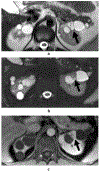Bosniak classification of cystic renal masses, version 2019: interpretation pitfalls and recommendations to avoid misclassification
- PMID: 33484283
- PMCID: PMC8751648
- DOI: 10.1007/s00261-020-02906-8
Bosniak classification of cystic renal masses, version 2019: interpretation pitfalls and recommendations to avoid misclassification
Abstract
The purpose of this review is to describe the potential sources of variability or discrepancy in interpretation of cystic renal masses under the Bosniak v2019 classification system. Strategies to avoid these pitfalls and clinical examples of diagnostic approaches are also presented. Potential pitfalls in the application of Bosniak v2019 are divided into three categories: interpretative, technical, and mass related. An organized, comprehensive review of possible discrepancies in interpreting Bosniak v2019 cystic masses is presented with pictorial examples of difficult clinical cases and proposed solutions. The scheme provided can guide readers to consistent, precise application of the classification system. Radiologists should be aware of the possible sources of misinterpretation of cystic renal masses when applying Bosniak v2019. Knowing which features and types of cystic masses are prone to interpretive errors, in addition to the inherent trade-offs between the CT and MR techniques used to characterize them, can help radiologists avoid these pitfalls.
Keywords: Cysts; Diagnostic error; Kidney; Kidney neoplasms; Magnetic resonance imaging; Renal cell carcinomas.
Figures










References
-
- Davies L, Petitti DB, Woo M, Lin JS. Defining, Estimating, and Communicating Overdiagnosis in Cancer Screening. Ann Intern Med 2018; 169:739 - PubMed
-
- Esserman LJ, Thompson IM Jr., Reid B. Overdiagnosis and overtreatment in cancer: an opportunity for improvement. JAMA 2013; 310:797–798 - PubMed
-
- Tse JR, Shen J, Shen L, Yoon L, Kamaya A. Bosniak Classification of Cystic Renal Masses Version 2019: Comparison of Categorization using CT and MRI. AJR American journal of roentgenology 2020; - PubMed
-
- Tse JR, Shen J, Yoon L, Kamaya A. Bosniak Classification Version 2019 of Cystic Renal Masses Assessed With MRI. AJR American journal of roentgenology 2020; 215:413–419 - PubMed
Publication types
MeSH terms
Grants and funding
LinkOut - more resources
Full Text Sources
Other Literature Sources
Medical

